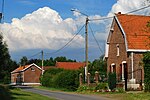Winter operations 1914–1915 is the name given to military operations during the First World War, from 23 November 1914 – 6 February 1915, in the 1921 report of the British government Battles Nomenclature Committee. The operations took place on the part of the Western Front held by the British Expeditionary Force (BEF), in French and Belgian Flanders.
After the northern flank of the Western Front had disappeared during the Race to the Sea in late 1914, the Franco-British attacked towards Lille in October, then the BEF, Belgians and the French Eighth Army attacked in Belgium. A German offensive began on 21 October but the 4th Army (Generaloberst Albrecht, Duke of Württemberg) and 6th Army (Generaloberst Rupprecht, Crown Prince of Bavaria) were only able to take small amounts of ground, at great cost to both sides, at the Battle of the Yser (16–31 October) and further south in the First Battle of Ypres (19 October – 22 November).
By 8 November, the Germans realised that the advance along the coast had failed and that taking Ypres was impossible. Attacks by both sides had quickly been defeated and the opposing armies had improvised field defences, against which attacks were costly failures. By the end of the First Battle of Ypres in November 1914, both sides were exhausted, short of ammunition and suffering from collapses in morale; some infantry units refused orders. The mutual defeat of the First Battle of Flanders was followed by trench warfare, in which both sides tried to improve their positions as far as the winter weather, mutual exhaustion and chronic equipment and ammunition shortages allowed.










